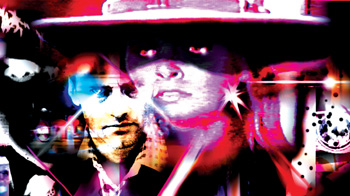![[Metroactive Arts]](/arts/gifs/art468.gif)
[ Arts Index | Silicon Valley | Metroactive Home | Archives ]

How the West Was Projected: Jeremy Blake's 'Century 21' mingles images from the movies and myth. Rifling The Past Sarah Winchester's compulsion to sprawl lives on in Jeremy Blake's motion-picture paintings A MADWOMAN'S wooden folly sums up the spirit of the valley. Just as the towers of great cities represent civic aspirations to grow skyward, the Winchester Mystery House symbolizes the Santa Clara Valley's urge to sprawl laterally. The valley's most famous tourist attraction forms the basis for Jeremy Blake's Winchester trilogy at the San Francisco Museum of Modern Art. The Winchester House's history is the stuff of local legend. Sarah Winchester, heiress to the rifle fortune, lost her husband and her son and inherited $20 million. A medium told the unhappy widow that she must move West and build a home that would hold the spirits of the numberless dead killed by her family's weapons. As long as Sarah Winchester lived in her house, the construction never stopped. From 1884 until 1922, the mansion sprouted new doors and floors and wings. The windows were ornamented with motifs of the number 13. The mad Sarah died, but the building continues apace, from the Coyote Valley to the Palo Alto foothills. Blake's "time-based paintings"—Winchester (2002, 18 min.), 1906 (2003, 21 min.) and Century 21 (2004, 12 min.)—are looped DVDs projected side by side. The first two explore the house itself, before and after the San Francisco earthquake. But what really piqued Blake's interest was the World's Fair futurism of the domes of the nearby Century movie theaters. Either it is coincidence or a clever reference, but as Mitchell Schwartzer notes in the catalog, Century 21 was built for Cinerama and used for spectacles like How the West Was Won. Three projectors side by side threw their light on a curved 34-by-84-foot screen. The trilogy is almost cinema but not quite. The shifting light on a flat surface comes closer to pixilation and stop-motion animation. Yet Blake doesn't go in for the stutter and jitter of most digital filmmaking. He favors calm, often slow dissolves. Figures emerge from abstractions. In Century 21, we can see a cowboy-hatted woman with cat's-yellow eyes—Raquel Welch in the cheesecake Western Hannie Caulder (she is Blake's Sarah Winchester surrogate). Drilled through the eyes, a gunslinger sits as an airbrushed rainbow snake emerging from the bullet hole. Appropriated drawings materialize and fade: an off-register print of Peter Pan's Lost Boys amid neon bars and flurries of white light; an image from a Charles Addams cartoon of a group of 1950s children playing cowboy and chasing a little green man with their guns back into his space ship. In its cowboys vs. flying saucers imagery, the cartoon seems to link the extraterrestrial Century Domes and the House That Rifles Built. A sound collage murmurs as the soundtracks for the three sections merge. We hear sound effects of the Western movies: the wail of a harmonica, the creaking of wagon wheels. A trilling music-box version of "The Stars and Stripes Forever" fades into the psychedelic intro to the Rolling Stones' "2,000 Light Years from Home." Blake's work overcomes the problem of computer-generated color—how cold and flat the uniform saturation of color can be. His hues make you think of stained glass, not plastic. His "brush strokes" of light represent a giant step past spray-painted graffiti art, which is his art's nearest cousin. Winchester proves that our supposedly bland and history-free valley has its "historical narrative," as Blake says. Never again can one feel contempt for Sarah Winchester's gullibility. Blake describes his piece as "an act of compassion." And this is true of the mansion itself. Seen as Blake sees it, the Winchester House is not just the heart of our valley, but our most subtle monument to those slain by gun violence.
Winchester runs through Oct. 10 at the San Francisco Museum of Modern Art, 151 Third St., San Francisco. (415.357.4000)
Send a letter to the editor about this story to letters@metronews.com. [ Silicon Valley | Metroactive Home | Archives ]
|
From the April 6-12, 2005 issue of Metro, Silicon Valley's Weekly Newspaper.
Copyright © Metro Publishing Inc. Metroactive is affiliated with the Boulevards Network.
For more information about the San Jose/Silicon Valley area, visit sanjose.com.